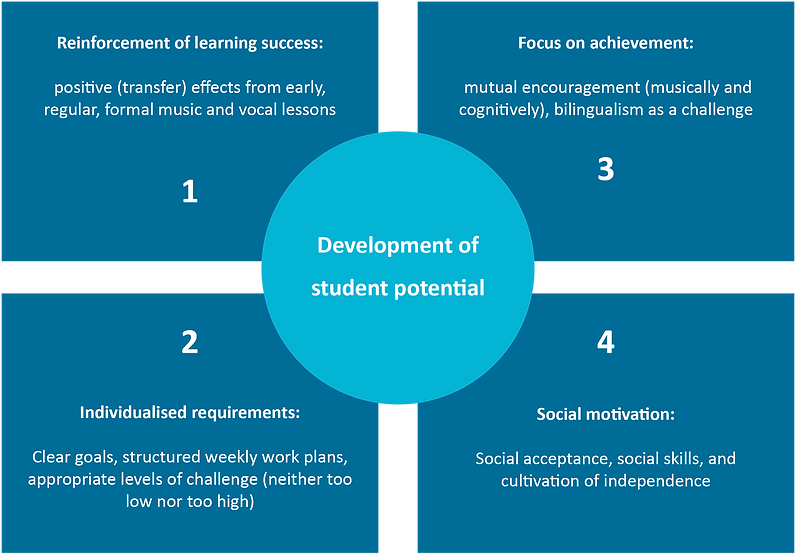Educational methodology
We have put knowledge from paedogogical research and neuroscience into practice at Cantaleum. Music and bilingualism play the central roles in the success of this approach.

Success Factor 1: Reinforcement
Singing and making music reinforces learning abilities through:
-
attention, ability to concentrate
-
acoustic memory
-
learned musical patterns (melody, rhythm, tempo) and sensomotor skills required for singing combine to train self-monitoring, self-correction, and fine motor skills
-
deeper abdominal (diaphragmic) breathing and diaphragmic vibration reduces feelings of uncertainty and fear
-
reduced adrenalin levels
-
increased production of oxytocin (“the social bonding hormone”) enhances ability to empathise with others
-
increased serotonin levels (“the mood-enhancing hormone”)
Sources: Schellenberg, 2004, as cited by Jäncke, 2008; Blank & Adamek, 2010
Success factor 2: Individualisation
Successful, individualised learning is a result of the following factors:
-
clear purpose of learning, clear goals and appropriately-challenging learning requirements, and encouragement toward achievement
-
use of varied and targeted teaching methods with special emphasis on feedback
-
viewing learning and teaching from the perspective of students
-
placing value on teaching learning techniques and learning strategies
Sources: Waxman, Wang, Anderson & Walberg, 1985, as cited by Hattie, 2013
Success factor 3:
Focus
Positive focus through:
-
challenges set at an appropriate level
-
finding connections between different subjects and topics
-
peers interested in the same topics
-
bilingual way of life in a day school setting
Source: Hattie, 2013
Success factor 4: Motivation
Practicing independence, new skills, and social integration through:
-
individual and ensemble singing
-
freedom of choice and freedom of action
-
experiencing self-efficacy through own actions and performance
Sources: Deci & Ryan, 1993, as cited in Berlinger, Birri & Zumsteg, 2006; Heckhausen & Heckhausen, 2010
